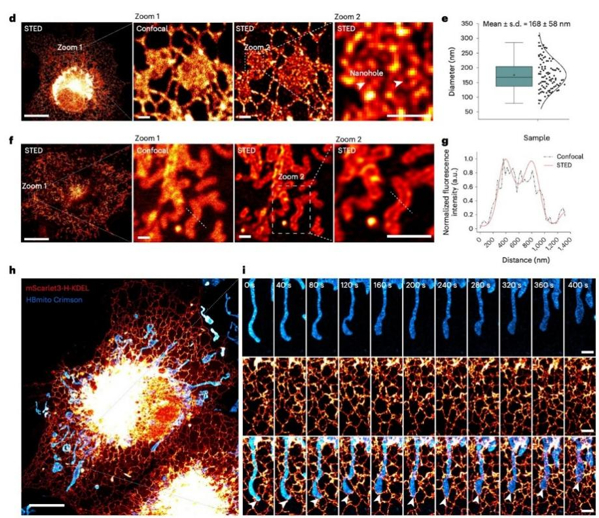

Figure mScarlet3-H: STED super-resolution images of different
organelles
With the support of the National Natural Science Foundation of China Youth
Science Fund Project (Class C) (Approval No. 32201235) and other grants, Fu
Zhifei's team and collaborators at Fujian Medical University have made progress
in the research of genetic coding fluorescent probes. The related research,
titled "A highly stable monomeric red fluorescent protein for advanced
microscopy", was published in Nature Methods on April 17, 2025. Paper link:
https://www.nature.com/articles/s41592-025-02676-5 .
In recent years, the successful development of multiple green and yellow
ultra stable fluorescent proteins has greatly promoted the development of
cutting-edge biological imaging technologies. Compared to green and yellow
fluorescent proteins, red fluorescent protein has natural advantages, especially
in terms of phototoxicity, spontaneous fluorescence, light scattering, and
tissue penetration. However, the stability of existing red fluorescent proteins
has significant shortcomings, greatly limiting the development of cutting-edge
biological imaging technologies.
The Fu Zhifei team and collaborators have successfully developed the ultra
stable monomeric red fluorescent protein mScarlet3-H (also known as mYongHong,
meaning eternal red) using methods such as structural biology and protein
artificial evolution. This fluorescent protein has strong chemical stability,
thermal stability, and photostability, and is currently the preferred
fluorescent probe for optoelectronic correlation imaging technology, rapid
transparency imaging technology, and long-term live cell super-resolution
imaging technology. The emergence of mScarlet3-H has successfully filled the
long-standing gap in the lack of ultra stable monomeric red fluorescent
protein.
This study demonstrates important achievements in the field of genetically
encoded fluorescent probes, providing important labeling tools for cell biology,
neurobiology, and other research. It also lays an important research foundation
for the development of related functional fluorescent probes.